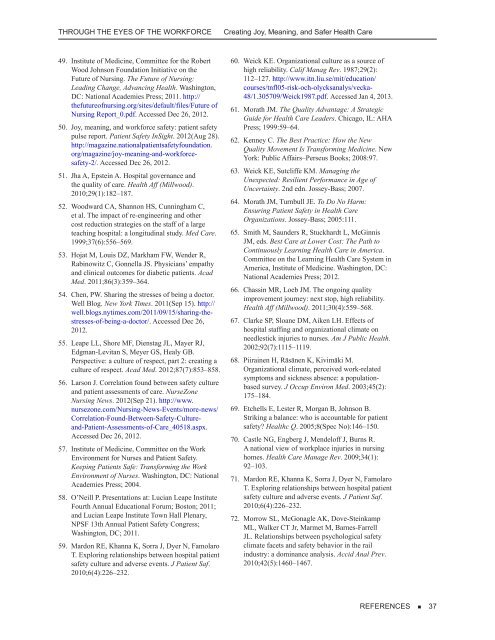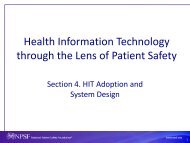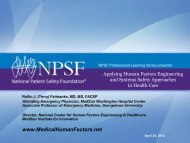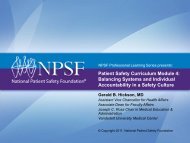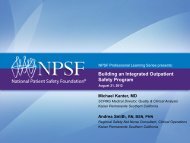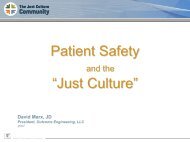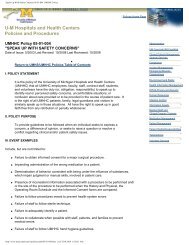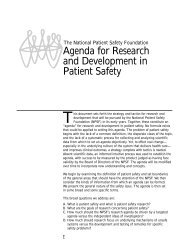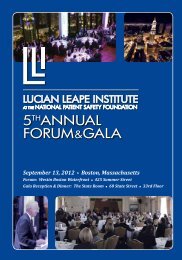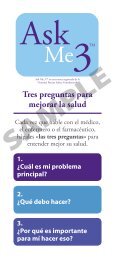Through The eyes of The Workforce - National Patient Safety ...
Through The eyes of The Workforce - National Patient Safety ...
Through The eyes of The Workforce - National Patient Safety ...
Create successful ePaper yourself
Turn your PDF publications into a flip-book with our unique Google optimized e-Paper software.
THROUGH THE EYES OF THE WORKFORCECreating Joy, Meaning, and Safer Health Care49. Institute <strong>of</strong> Medicine, Committee for the RobertWood Johnson Foundation Initiative on theFuture <strong>of</strong> Nursing. <strong>The</strong> Future <strong>of</strong> Nursing:Leading Change, Advancing Health. Washington,DC: <strong>National</strong> Academies Press; 2011. http://thefuture<strong>of</strong>nursing.org/sites/default/files/Future <strong>of</strong>Nursing Report_0.pdf. Accessed Dec 26, 2012.50. Joy, meaning, and workforce safety: patient safetypulse report. <strong>Patient</strong> <strong>Safety</strong> InSight. 2012(Aug 28).http://magazine.nationalpatientsafetyfoundation.org/magazine/joy-meaning-and-workforcesafety-2/.Accessed Dec 26, 2012.51. Jha A, Epstein A. Hospital governance andthe quality <strong>of</strong> care. Health Aff (Millwood).2010;29(1):182–187.52. Woodward CA, Shannon HS, Cunningham C,et al. <strong>The</strong> impact <strong>of</strong> re-engineering and othercost reduction strategies on the staff <strong>of</strong> a largeteaching hospital: a longitudinal study. Med Care.1999;37(6):556–569.53. Hojat M, Louis DZ, Markham FW, Wender R,Rabinowitz C, Gonnella JS. Physicians’ empathyand clinical outcomes for diabetic patients. AcadMed. 2011;86(3):359–364.54. Chen, PW. Sharing the stresses <strong>of</strong> being a doctor.Well Blog. New York Times. 2011(Sep 15). http://well.blogs.nytimes.com/2011/09/15/sharing-thestresses-<strong>of</strong>-being-a-doctor/.Accessed Dec 26,2012.55. Leape LL, Shore MF, Dienstag JL, Mayer RJ,Edgman-Levitan S, Meyer GS, Healy GB.Perspective: a culture <strong>of</strong> respect, part 2: creating aculture <strong>of</strong> respect. Acad Med. 2012;87(7):853–858.56. Larson J. Correlation found between safety cultureand patient assessments <strong>of</strong> care. NurseZoneNursing News. 2012(Sep 21). http://www.nursezone.com/Nursing-News-Events/more-news/Correlation-Found-Between-<strong>Safety</strong>-Cultureand-<strong>Patient</strong>-Assessments-<strong>of</strong>-Care_40518.aspx.Accessed Dec 26, 2012.57. Institute <strong>of</strong> Medicine, Committee on the WorkEnvironment for Nurses and <strong>Patient</strong> <strong>Safety</strong>.Keeping <strong>Patient</strong>s Safe: Transforming the WorkEnvironment <strong>of</strong> Nurses. Washington, DC: <strong>National</strong>Academies Press; 2004.58. O’Neill P. Presentations at: Lucian Leape InstituteFourth Annual Educational Forum; Boston; 2011;and Lucian Leape Institute Town Hall Plenary,NPSF 13th Annual <strong>Patient</strong> <strong>Safety</strong> Congress;Washington, DC; 2011.59. Mardon RE, Khanna K, Sorra J, Dyer N, FamolaroT. Exploring relationships between hospital patientsafety culture and adverse events. J <strong>Patient</strong> Saf.2010;6(4):226–232.60. Weick KE. Organizational culture as a source <strong>of</strong>high reliability. Calif Manag Rev. 1987;29(2):112–127. http://www.itn.liu.se/mit/education/courses/tnfl05-risk-och-olycksanalys/vecka-48/1.305709/Weick1987.pdf. Accessed Jan 4, 2013.61. Morath JM. <strong>The</strong> Quality Advantage: A StrategicGuide for Health Care Leaders. Chicago, IL: AHAPress; 1999:59–64.62. Kenney C. <strong>The</strong> Best Practice: How the NewQuality Movement Is Transforming Medicine. NewYork: Public Affairs–Perseus Books; 2008:97.63. Weick KE, Sutcliffe KM. Managing theUnexpected: Resilient Performance in Age <strong>of</strong>Uncertainty. 2nd edn. Jossey-Bass; 2007.64. Morath JM, Turnbull JE. To Do No Harm:Ensuring <strong>Patient</strong> <strong>Safety</strong> in Health CareOrganizations. Jossey-Bass; 2005:111.65. Smith M, Saunders R, Stuckhardt L, McGinnisJM, eds. Best Care at Lower Cost: <strong>The</strong> Path toContinuously Learning Health Care in America.Committee on the Learning Health Care System inAmerica, Institute <strong>of</strong> Medicine. Washington, DC:<strong>National</strong> Academies Press; 2012.66. Chassin MR, Loeb JM. <strong>The</strong> ongoing qualityimprovement journey: next stop, high reliability.Health Aff (Millwood). 2011;30(4):559–568.67. Clarke SP, Sloane DM, Aiken LH. Effects <strong>of</strong>hospital staffing and organizational climate onneedlestick injuries to nurses. Am J Public Health.2002;92(7):1115–1119.68. Piirainen H, Räsänen K, Kivimäki M.Organizational climate, perceived work-relatedsymptoms and sickness absence: a populationbasedsurvey. J Occup Environ Med. 2003;45(2):175–184.69. Etchells E, Lester R, Morgan B, Johnson B.Striking a balance: who is accountable for patientsafety? Healthc Q. 2005;8(Spec No):146–150.70. Castle NG, Engberg J, Mendel<strong>of</strong>f J, Burns R.A national view <strong>of</strong> workplace injuries in nursinghomes. Health Care Manage Rev. 2009;34(1):92–103.71. Mardon RE, Khanna K, Sorra J, Dyer N, FamolaroT. Exploring relationships between hospital patientsafety culture and adverse events. J <strong>Patient</strong> Saf.2010;6(4):226–232.72. Morrow SL, McGonagle AK, Dove-SteinkampML, Walker CT Jr, Marmet M, Barnes-FarrellJL. Relationships between psychological safetyclimate facets and safety behavior in the railindustry: a dominance analysis. Accid Anal Prev.2010;42(5):1460–1467.References • 37


